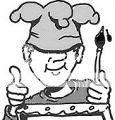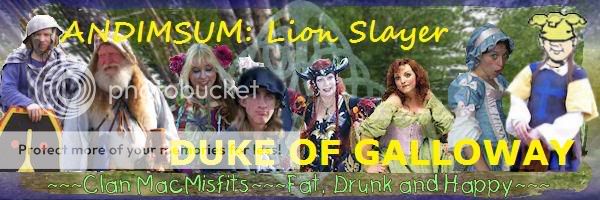Ready to make a wager?
Elizabethans were generally pious, but they loved their gambling. From the epic boar-baiting to the no-less ferocious rat-baiting, from cards to dice, and gameboards scratched in the cathedral pews (really) -- you'd have no problem finding someone to cover your bet. There are many pleasant card and dice games suitable for Faire but they lack a certain spectacle. In the absence of the bloodsports (there being generally more pet rats than pet terriers on any given fairesite), I've found several period games that make fine street sport.
Nine-Man Morris
Nine-man Morris is an excellent street game. The board can be scratched in the dirt of the street, painted on a cloth, or carved into a table. The 18 markers can be rocks, coins, wizened apples, or what-hae-ye (mongers were fond of beets vs turnips). The game is easily taught to passers-by and finishes up within 5-15 minutes. I've found it appealing to both children and adults and a fine way to take an afternoon ale break. The only downside is if, as Shakespeare's Titania laments, "The nine-men's morris [fills] up with mud."
The board consists of 3 nested squares with lines connecting the mid-point of each side. The gameplay is similar to tic-tac-toe: players alternate placing markers on the 24 intersections, attempting to get three-in-a-row. A line-of-three is called a mill. When a mill is created, the player may then remove (pound) one opposing non-mill piece from the board. A pounded piece is out of play.
Once all markers have been placed on the board (pounded off or not) the gameplay changes slightly. Instead of adding a marker, players now slide their markers along the lines. The game ends when a player has only two pieces left or is pinned-in and unable to make a move.
Variations include: disallowing shifting a single piece in/out of the same mill; pounding mills if no other piece is available; changing sliding to flying to any open intersection when reduced to 3 markers; six-man morris with 2 squares; twelve-man morris with 3 squares, midpoints and diagonals connected.
Quoits
Quoits is essentially horseshoes but using a ring (the Quoit) rather than a shoe. Generally played with pins (Hobs) driven into the ground (at 15-25 paces), you can also use baskets or tankards or whatever. It is easy to make Quoits by bending straw into a circle and lashing it in place with a ribbon or string. Give them enough mass for a nice toss. Quoits looks great in the street and makes a fine spectacle when down on your belly measuring the distance from the Hob with a length of twine.
With two Hobs and 1-3 Quoits per player, players stand a toe to the Hob and cast their Quoits at the distant Hob. Ringing the Hob is worth two points, having the closest Quoit is worth one point. Play to five or some reasonable score.
Variations include: horseshoes; scoring additional points for each Quoit closer to the Hob than all the other player's Quoits.
Fox & Geese
Fox and Geese has a more complicated board than Nine-man Morris and is better suited to a painted playing board (cloth, wood, etc) than scratched in the dirt. The 13 (or 17) Geese start at one side of the board, and moving only forwards and forwards diagonally, try to trap the single Fox. The Fox meanwhile may move in any direction and tries to jump a Goose thereby removing it from play. The Geese move and the Fox jumps, as in checkers. The Fox goes first.
The Geese win if they trap the Fox in a corner (and peck him to death), and the Fox wins if the Geese cannot trap him or have all moved to the far side of the board. This is a little more difficult as a street game because the advantage lies with the Fox. It may prove unsatisfying to merely play once (as the Geese).











